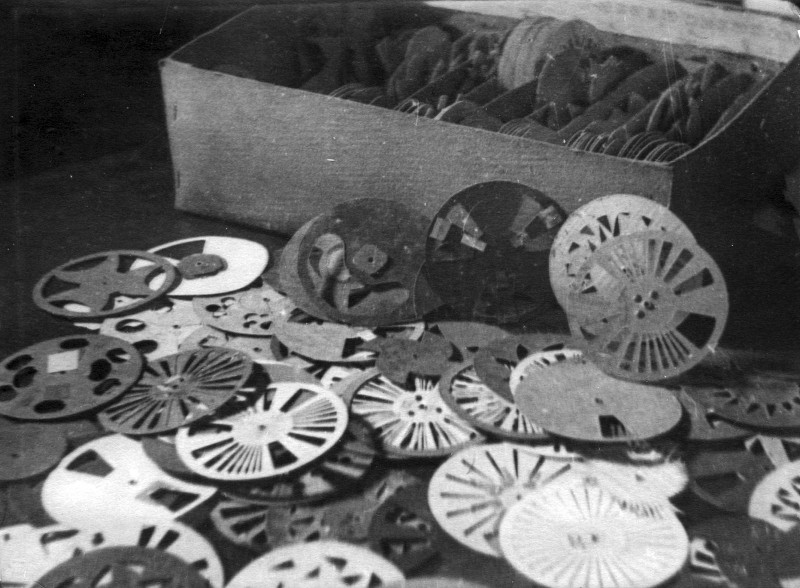When you think of early sound synthesis, what technologies come to mind? The Hammond Organ? Or perhaps its predecessor, Thaddeus Cahill’s Telharmonium? In the early 1920s and 30s, many Bauhaus artists were using paper and film to synthesize musical instruments.
A few of them experimented with the optical film soundtrack itself, drawing waveforms directly upon it. [Evgeny Sholpo] created an optical synthesizer he called the Variophone. It used cardboard disks with intricate cutout patterns that resembled spinning, sonic snowflakes.
During the early 1930s, an artist named [Nikolai Voinov] created short animated films that incorporated the cut paper sound technique. [Voinov]’s soundtrack looked like combs of varying fineness. For his animated figures, [Voinov] cut and pieced together characters from paper and made them move in time to his handmade paper soundtrack.
In [Voinov]’s “Dance of the Crow”, an animated crow struts his stuff from right to left and back again while working his beak in sync with the music. The overall effect is like a chiptunes concertina issuing forth from a crow-shaped pair of bellows. It’s really not to be missed.
Thanks for the tip, [Leo]!
Retrotechtacular is a weekly column featuring hacks, technology, and kitsch from ages of yore. Help keep it fresh by sending in your ideas for future installments.
















Cool!
The title “Hand-Synthesized Sound” brought thoughts of Brian Benchoff making fart sounds with his armpit.
I used a program way back in the early 2000s, or perhaps earlier, similar to AudioPaint. It used the red channel as either left or right, green as the other channel for stereo .wav files. I found it while trying to convert images from FFT visualizers back into sound, but it’s best use I found was for short samples. Long samples, even with complex curves, just didn’t have enough smooth continuity in the limited resolution I was working with (1920×1200) to be more than discrete notes and very dissonant. Short sample time with a little jitter per pixel (to vary the timing of those 1920 samples) made interesting noises.
Find an interesting area of the Mandelbrot set and want to hear it? output to .bmp, load in whatever the now deceased program was, and start tinkering with the settings. What low frequency, high cut off, how long is the sample, stereo or mono, linear or logarithmic? Then chuck the sample over to Buzz, and start rocking out.
It was Coagula. Uses the blue channel, optionally, for noise, which isn’t really useful but I suppose he had to do something with blue. It’s an interesting program, and a new way of creating unique sounds. It’s free to use.
I tried to remember the name by searching through my hard drive, turned out quicker to Google it instead.
Hah, my experience too, the not remembering the name of software and not being able to find it by searching the millions of files on the HD and having more luck with a search engine.
I just did a search and found i still have coagula on my HD btw. It’s actually a good thing to design and make alert and notification sounds.
When I saw the subject line of this posting I thought of the 75 year old “Voder” that a highly trained/skilled operator could synthesize rather good quality realtime continuous speech from by using a number of keys and foot pedals. Really impressive stuff.
I’m not sure if it has been on retrotachtacular before or not – but it’s still cool and worth a re-watching.
https://www.youtube.com/watch?v=5hyI_dM5cGo
Yes, it has been on Retrotachtacular:
http://hackaday.com/2014/08/12/retrotechtacular-the-voder-from-bell-labs/
Film of part of that presentation. https://www.youtube.com/watch?v=0rAyrmm7vv0 A bit of work to combine that with the primitive voice recognition demonstrated by Westinghouse https://www.youtube.com/watch?v=AuyTRbj8QSA could have led to the creation of voicemail and automated telemarketing decades sooner.
Anyone remember the old DOS program “Sputter Sound System”? It could play and convert many different types of digital audio files and came with several of various types.
That’s too far back for me, but it did remind me to see if there are any updates for SOX. http://sox.sourceforge.net/
Using optics to make sounds: http://120years.net/the-welte-licht-ton-orgele-weltegermany1936/